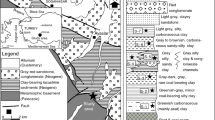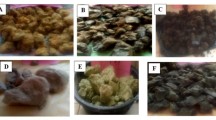Abstract
The present article addresses the potential usability of the Belevi clay from the Denizli region as a raw material in different ceramic applications and industrial products by investigating their mineralogical (X-ray diffraction), chemical (X-ray fluorescence), thermal (differential thermal analyzer-thermogravimetry), physical, firing, and geotechnical characteristics. For this context, cylindrical samples have been prepared and fired from 700 to 1200 °C; the mineralogical transformations during the firing process were obtained by X-ray diffraction. After that, linear firing shrinkage, bulk density (BD), water absorption (WA), unconfined compression strength (UCS), and ultrasonic pulse velocity (Vp) values of all of the samples were measured. In mineralogical point of view, samples were considered smectitic clays (56%) and rarely chlorite, illite, and kaolinite. In addition, calcite, quartz, feldspar, and dolomite minerals are observed in small quantities. Chemically, the major oxides of Belevi clay consist of SiO2, Al2O3, and Fe2O3 and characterized by higher CaO contents. The studied samples are generally composed of fine particles (clayey-silty). The plasticity indices (PI) are determined with a high value as 19%; this suggests that the studied clays are highly plastic raw materials. Samples with the particle size < 2 μm are abundant in clay deposits (∼ 20%), which is suitable for the ceramic applications. The presence of silt fraction in Belevi clay material can be eliminated by crushing and sieving. The main transformations during firing processes of the samples were determined at 900 °C together with the appearance of new crystalline phases especially anorthite, diopside, gehlenite, and hematite. An increase in the firing shrinkage and bulk density values with decrease in water absorption values is determined at 1000 °C and above. UCS and Vp values are also started to increase significantly from 900 °C due to mineralogical transformation. Technical tests show that Belevi clays are suitable in manufacturing of porous structural ceramic products such as brick and tiles, and also in pottery production.















Similar content being viewed by others
References
Baccour H, Medhioub M, Jamoussi F, Mhiri T, Daoud A (2008) Mineralogical evaluation and industrial applications of the Triassic clay deposits, Southern Tunisia. Mater Charact 59:1613–1622
Bergaya F, Theng BKG, Lagaly G (2006) Handbook of clay science. Developments in Clay Science Vol. 1. Elsevier Ltd 1246p
Boussen S, Sghaier D, Chaabani F, Jamoussi B, Bennour A (2016) Characteristics and industrial application of the Lower Cretaceous clay deposits (Bouhedra Formation), Southeast Tunisia: potential use for the manufacturing of ceramic tiles and bricks. Appl Clay Sci 123:210–221
Casagrande A (1947) Classification and identification of soils. ASCE Transactions Paper No. 2351 901–991
Casagrande A (1948) Plasticity chart for the classification of cohesive soils. T Am Soc Civ Eng 113:901
Çelik H (2010) Technological characterization and industrial application of two Turkish clays for the ceramic industry. Appl Clay Sci 50:245–254
Chang LLY (2002) Industrial mineralogy: materials, processes, and uses. Prentice Hall, Upper Saddle River
Cultrone G, Sebastian E, Elerk K, De la Torre MJ, Cazalla O, Rodriguez-Navarro C (2004) Influence of mineralogy and firing temperature on the porosity of bricks. J Eur Ceram Soc 24:547–564
Diko ML, Ekosse GE, Ayonghe SN, Ntasin EB (2011) Physical characterization of clayey materials from tertiary volcanic cones in Limbe (Cameroon) for ceramic applications. Appl Clay Sci 51:380–384
Dondi M, Fabbri B, Laviano R (1992) Characteristics of the clays utilized in the brick industry in Apulia and Basilicata (Southern Italy). Mineral Petrologica Acta 35:181–191
Dondi M, Raimondo M, Zanelli C (2014) Clays and bodies for ceramic tiles: reappraisal and technological classification. Appl Clay Sci 96:91–109
Ekosse GE, Ngole V, Sendze Y, Ayonghe SN (2005) Environmental mineralogy of unconsolidated surface sediments associated with the 2001 landslides on volcanic cones, Mabeta New Layout, Limbe, Cameroon. Global J Environ Sci 4(2):115–122
El Ouahabi M, Daoudi L, Fagel N (2014) Preliminary mineralogical and geotechnical characterization of clays from Morocco: application to ceramic industry. Clay Miner 49:35–51
Guggenheim S (1997) Teaching mineralogy. In: Brady J, Mogk DW, Perkins D (eds) A workbook published by the Mineralogical Society of America, p 406
Hajjaji W, Moussi B, Hachani M, Medhioub M, Lopez-Galindo A, Rocha F, Labrincha JA, Jamoussi F (2010) The potential use of Tithonian–Barremian detrital deposits from central Tunisia as raw materials for ceramic tiles and pigments. Appl Clay Sci 48:552–560
Holtz RD, Kovacs WD (1981) An introduction to geotechnical engineering, Prentice- Hall, Inc., New Jersey, USA
Jordán MM, Sanfeliu T, de la Fuente C (2001) Firing transformations of tertiary clays used in the manufacturing of ceramic tile bodies. Appl Clay Sci 20:87–95
Kitouni S, Harabi A (2011) Sintering and mechanical properties of porcelains prepared from Algerian raw materials. Cerâmica 57:453–460
Konta J (1995) Clay and man: clay raw materials in the service of man. Appl Clay Sci 10:275–335
Kreimeyer R (1987) Some notes on the firing colour of clay bricks. Appl Clay Sci 2:175–183
Manoharan C, Sutharsan P, Dhanapandian S, Venkatachalapathy R (2012) Characteristics of some clay materials from Tamilnadu, India, and their possible ceramic uses. Cerâmica 58:412–418
Manukaji John U (2013) Chemical and mechanical characterization of clay samples from Kaduna State Nigeria. IJEI 2-7:20–26
Maritan L, Nodari L, Mazzoli C, Milano A, Russo U (2006) Influence of firing conditions on ceramic products: experimental study on clay rich in organic matter. Appl Clay Sci 31(1):1–15
Meseguer S, Pardo F, Jordán MM, Sanfeliu T, González I (2010) Ceramic behavior of five Chilean clays which can be used in the manufacture of ceramic tile bodies. Appl Clay Sci 47:372–377
Milheiro FAC, Freire MN, Silva AD, Holanda JNF (2005) Densification behavior of a red firing Brazilian kaolinitic clay. Ceram Int 31(5):757–763
Mohmoudi S, Srasra E, Zargouni F (2008) The use of Tunisian Barremian clay in the traditional ceramic industry: optimization of ceramic properties. Appl Clay Sci 42:125–129
Monterio SN, Vieira CMF (2004) Influence of firing temperature on the ceramic properties of clays from Campos dos Goytacazes, Brazil. Appl Clay Sci 27:229–234
Murray HH (2000) Traditional and new applications for kaolin, smectite, palygorskite: a general overview. Appl Clay Sci 17:207–221
Murray HH (2007) Applied clay mineralogy. Developments in Clay Science 2, Elsevier BV. 180p
Ngun BK, Mohamad H, Sulaiman SK, Okada K, Ahmad ZA (2011) Some ceramic properties of clays from central Cambodia. Appl Clay Sci 53:33–41
Nodari L, Marcuz E, Maritan L, Mazzoli C, Russo U (2007) Hematite nucleation and growth in the firing of carbonate-rich clay for pottery production. J Eur Ceram Soc 27(16):4665–4673
Okay Aİ (1989) Geology of Menderes Massif and Lycian Nappes in the south of Denizli. Bull Mineral Res Explor 109:45–58 (In Turkish)
Özkan İ (2014) Ceramic properties of a Turkish clay in the Aydın region. J Ceram Process Res 15-1:44–47
Özkan İ, Çolak M, Oyman RE (2010) Characterization of waste clay from the Sardes (Salihli) placer gold mine and its utilization in floor-tile manufacture. Appl Clay Sci 49:420–425
Özpınar Y, Hançer M, Semiz B (2002) Clays in Denizli region (southwestern Anatolia), Turkey. Geol Carpath 53(2):109–116
Proceq (2014) Pundit lab/Pundit lab+ ultrasonic instrument operating instructions. Proceq SA, 31p
Segnit ER, Anderson CA (1972) Scanning electron microscopy of fired illite. Trans Brit Ceram Soc 71:85–88
Semiz B (2017) Characteristics of clay-rich raw materials for ceramic applications in Denizli region (Western Anatolia). Appl Clay Sci 137:83–93
Semiz B (2018) Characteristics of clays from Pamukkale (Denizli) region, and their usability in ceramic sector, PAJES 24(6):1237–1244. https://doi.org/10.5505/pajes.2017.77853
Şimşek Ş (1984) Denizli-Kızıldere-Tekkehamam-Tosunlar-Buldan-Yenice alanının jeolojisi ve jeotermal enerji olanakları. Mineral Res. Expl. Direct. Turkey (MTA), Scientific Report No:7846, 85p. Ankara, Turkey
Söylemez M, Demir A, Onar AF (2011) The Effect of firing temperature on some physical properties of brick. CBU Journal of Science 7(2):71–80
Sun S (1990) Denizli-Uşak Arasının Jeolojisi ve Linyit Olanakları. General Directorate of Mineral Research and Exploration Institute of Turkey (MTA), Ankara, Scientific Report No:9985, 92p
Tite MS, Maniatis Y (1975) Examination of ancient pottery using the scanning electron microscope. Nature 257:122–123
Trindade MJ, Dias MI, Coroado J, Rocha F (2009) Mineralogical transformations of calcareous rich clays with firing: a comparative study between calcite and dolomite rich clays from Algarve, Portugal. App Clay Sci 42:345–355
Acknowledgments
The authors wish to express their sincere gratitude to Yusuf Ahmet Çetinkaya and Özgür Dinç for their support in a part of laboratory studies, to Assist. Prof. Dr. Sevil Söyleyici for conducting DTA analyses, and to Prof. Dr. Ömer Bozkaya, İrem Ganiz, and Ömer Faruk Özkaya for their support in XRD analyses for both whole rock and clay fraction. Prof. Dr. Mohamed Tharwat Salah Heikal (Professor of Mineralogy and Petrology, Geology Department, Faculty of science at Tanta University, Egypt) is acknowledged for his critical comments that contributed to the improvement of this paper.
Author information
Authors and Affiliations
Corresponding author
Additional information
Responsible Editor: Domenico M. Doronzo
Rights and permissions
About this article
Cite this article
Semiz, B., Çelik, S.B. Mineralogical and geochemical characteristics of Belevi clay deposits at Denizli, SW Turkey: industrial raw material potential. Arab J Geosci 13, 313 (2020). https://doi.org/10.1007/s12517-020-05292-z
Received:
Accepted:
Published:
DOI: https://doi.org/10.1007/s12517-020-05292-z




